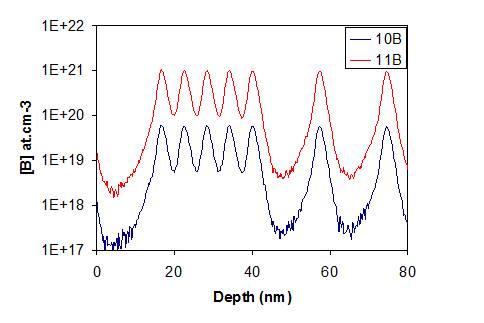SIMS
Secondary Ion Mass Spectrometry
Characterisation Installation 4
SIMS uses a focused, energetic primary ion beam to bombard the surface of the sample of interest. Sample atoms are sputtered and those that are ionized (secondary ions) are accelerated towards a mass spectrometer where they are mass separated before being detected. Either positive or negative secondary ions are detected. The use of a reactive primary ion beam can increase the secondary ion yield. Oxygen is used to increase positive secondary ion yield and cesium is used to increase negative secondary ion yield. There are three main types of spectrometer that are used to mass-separate the secondary ions, magnetic sector, time-of-flight, and quadrupole spectrometers. Magnetic SIMS provides the best detection limits whilst time-of-flight (TOF)-SIMS provides the highest surface sensitivity when used with a pulsed analysis gun. SIMS can provide surface mass spectra, images with lateral resolution in the 0.1 to 10 µm range and depth profiles with depth resolution in the 1 to 10 nm range. SIMS can be quantitative when reference samples are used and can achieve ppm or even ppb sensitivity. Profile depths can range from a few tens of nanometers to several tens of microns and any vacuum compatible sample can be analyzed. Some samples may require specific sample preparation (notably for biological samples) and analysis conditions. For example organic samples may be damaged by mono-atomic ion beams and the use of cluster ion beams (such as Argon clusters) can reduce this damage, thus enabling large molecular ions, characteristic of the sample to be detected.

TOF SIMS
Element profiling, surface contamination, molecular depth profiling, 2-D and 3-D imaging, FIB-ToF SIMS imaging, FIB-ToF-SIMS tomography
Bi pulsed sources, Cs, Xe, Argon cluster and O source for abrasion
Ga source for FIB sectioning
Electron gun for charge compensation
Argon cluster from 2 kV to 20 kV, cluster size from 500 to 5000 atoms per projectile
Cs, Xe, O, Ar monoatomic ion sputter source can operate from 250 eV to 2000 eV
Bi analysis source can operate from 15kV to 30kV
Ga FIB source operates at 30 kV
ION TOF Reflection TOF mass spectrometer with enhanced data rate technology to avoid detector saturation for intense signals (e.g. 28Si or Cs+)
Mass resolution up to 10000 m/dm.
Tilt angle +/- 5°, full rotation and access to all areas of a 100 mm wafer
Imaging can be performed on large areas up to 100 mm in diameter by rastering the stage

